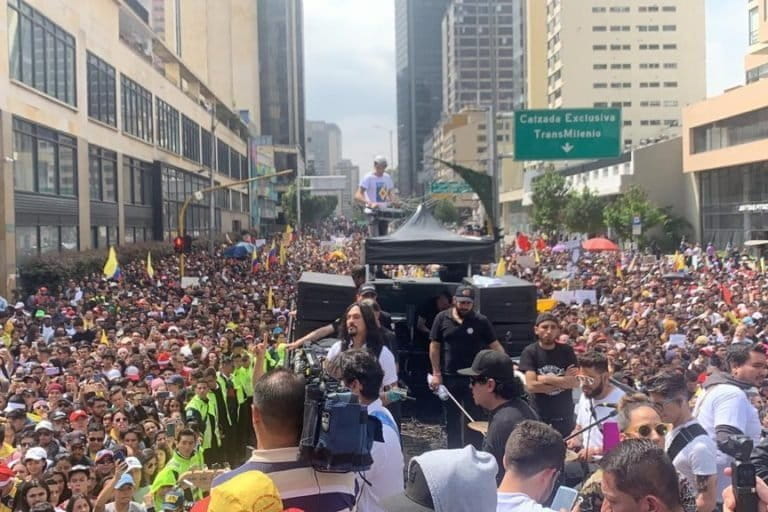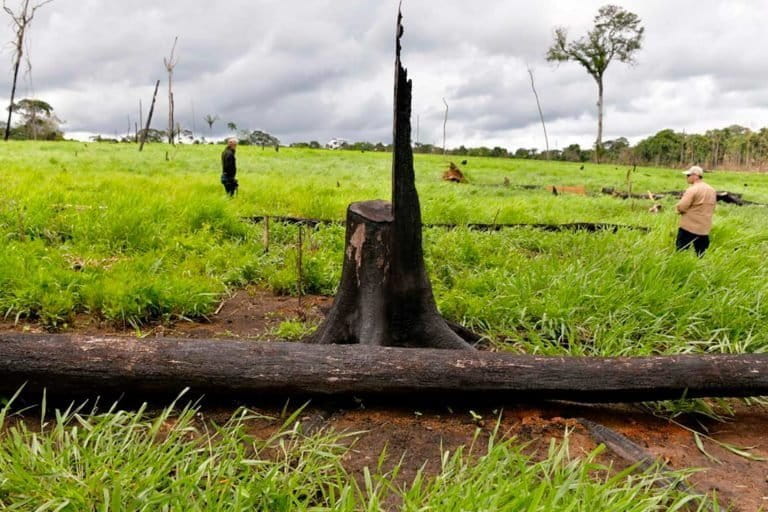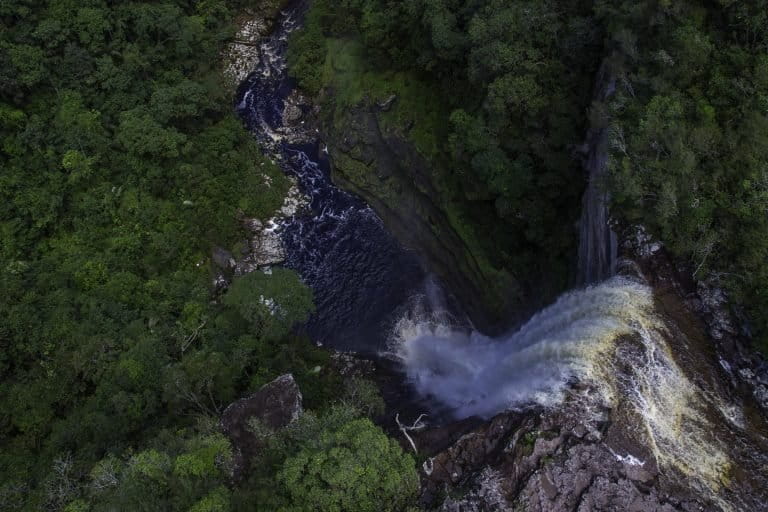- On Nov. 21, 2019, widespread national strikes began to break out in Colombia and have continued on and off since then.
- The protests include public demands over matters like austerity measures and working toward a robust domestic environmental agenda.
- Among the most intense issues for Colombia in 2019 were deforestation, the murders of social, environmental, and indigenous leaders, the debate over fracking, the increase in extractive activities, and restrictions on citizen participation in deciding the latter.
In Colombia, a year of crucial environmental decisions ended with a national strike that began on Nov. 21, 2019. Various social sectors say they are dissatisfied with President Iván Duque and his administration’s policies. Members of affected groups, including indigenous people, teachers, students, workers, and human rights activists, have been taking to the streets in protest.
Several Colombian environmental leaders have also united under what has been called the “National Strike Committee,” which demands solutions and actions from the government in the face of the murders of environmental and social leaders. The public outcry has given momentum to existing movements on the issues of deforestation, fracking, limits on citizen participation, and the protection of biodiversity.

So far, two major environmental negotiation meetings have taken place. The first, on Nov. 28, created tension as Carlos Andrés Santiago, of the National Environmental Movement of Colombia and the Alliance for a Colombia Free of Fracking, said the protestors wanted “negotiation and agreements, and not just for the president to listen, but that he takes concrete actions directed at solving the requests.”
A second meeting was held on Dec. 6. Ricardo Lozano, the minister of the environment, said the environmental issues would be prioritized and discussed during the next series of meetings.
The fight against deforestation
Reducing Colombia’s deforestation rate was one of the country’s main goals for 2019. In 2017, deforestation in Colombia totaled 219,973 hectares (543,565 acres), and 65.5 percent of that forest loss was concentrated in the Amazon. It was expected that the rate would increase in 2018, but Colombians were surprised to see a decrease of about 10 percent, to 197,159 ha (487,190 acres). These figures were published in July 2019 by the Institute of Hydrology, Meteorology and Environmental Studies (IDEAM) of Colombia.
However, a greater portion of the deforestation in 2018, 70 percent, was within the Amazon. Land grabbing, land speculation and extensive cattle ranching continue to grow, and three national parks — Tinigua, La Macarena, and Chiribiquete — continue to lose enormous swaths of forested areas.
According to a report by IDEAM, there was a 12 percent decrease in the number of deforestation alerts in the Amazon during the third quarter of 2019 compared to the third quarter of 2018. Lozano hailed the reduction, saying in November: “These are convincing results. We are on a great path, and President Iván Duque’s administration will continue to roll out efforts in the fight against deforestation, which is one of the nation’s highest priorities.”
But experts consulted by Mongabay Latam say they are still concerned by the situation. “I thought [the deforestation in the country] was very bad, like in all the Amazonian countries,” said Manuel Rodríguez, a former environment minister. He said the government’s goal of permitting between 600,000 and 1 million ha (about 1.5 million and 2.5 million acres) of deforestation over the course of four years seems “absolutely unacceptable; it does not make sense. This cannot be the goal of a government. It needs to be much more ambitious.” Rodríguez added that “the government juggles percentages of deforestation, but what matters in the end are the absolute numbers.”

In May 2019, the Colombian government publicly launched the Artemisa operation, a strategy to deploy the military in the fight against deforestation in the Amazon. The operation began in some national parks, including Chiribiquete, La Macarena, Tinigua, and Cordillera de los Picachos. At this point, little is known about the success of the operation.
Carlos Castaño Uribe is the director of the Caribbean Environmental Heritage Foundation and was the director of the Colombian National Natural Parks System for 11 years. In 1987, he took part in the scientific survey that would lead to the establishment of what is now Chiribiquete National Park. “I have not seen public reports, perhaps because it is still too early, but these military activities cannot be oblivious to a variety of complementary strategies,” he says. He adds it is necessary to provide opportunities to the many people living in the rainforest who, given their vulnerability, may end up being drawn into the destruction of their own forests. Rodríguez says it is important to create independent oversight processes and to follow up on their progress.
Uncertainty over fracking
Another important issue for Colombia in 2019 was fracking. On Aug. 1, 2018, a bill was introduced in parliament that sought a prohibition on fracking. Carlos Andrés Santiago, the spokesperson for the Alliance for a Colombia Free of Fracking, said that if the bill was not debated between March 16 and June 20, 2019, when the legislative period ended, then the project would sink.
That was exactly what happened, Santiago said, with parliamentary president José David Name, bumping the bill down to “sixth or seventh place on the agenda, and it was never debated, so the project sank.” Name has openly expressed favorable views of fracking, saying it “is a good alternative [to traditional oil and gas extraction] if done in a correct, controlled, and responsible way.”

The debate over fracking did not end there. In February 2019, a committee of experts met to discuss the viability of fracking. They reported that Colombia did not yet have sufficient information or tools to execute the technique.
The possibility of exploring and exploiting hydrocarbons using fracking was suspended by an order from the State Council, Colombia’s high court, in 2018. In late 2019, the State Council kept the fracking suspension in place, but ruled that it would allow pilot projects as long as they comply with the conditions determined by a committee of experts.
The National University of Colombia’s anticipated report to the State Council is meant to help toward a definitive decision on fracking. “Before any pilot projects, the conditions set by the committee must be fulfilled. For us, that will take at least two years,” Santiago said.
A definite ‘goodbye’ to popular consultations
In late 2018, the Constitutional Court of Colombia said popular consultations could no longer hinder extractive activities in territories where such consultations were previously required. In 2019, not only was this decision maintained, but the court also ruled that mining and hydrocarbon exploitation cannot be prohibited through municipal agreements.
“The ruling in late 2018 [about popular consultations] had another consequence, which was that it voided the Tauramena consultation of 2013,” says environmental lawyer Rodrigo Negrete. “They made the sentence retroactive for five years.” The current fear is that eight other popular consultations, which had all rejected proposed extractive activities, will also be voided.
“That was what the government and the extractive sector wanted,” Negrete said. “Right now, there is a tutela” — a judicial mechanism for the protection of fundamental rights — “before the State Council since we consider [the sentence] unconstitutional.”

Forty-eight municipal agreements had already been issued, but the vast majority were declared invalid by administrative courts in each department. “In 2016 and 2017, the Constitutional Court opened the door to activities like mining being prohibited using consultations and agreements, but two and a half years later, they said no,” Negrete said.
In 2019, all avenues to stop extractive activities were closed. Negrete said these are regressive decisions that favor centralism and deepen extractivism while worsening the lack of environmental protection.
Santiago said the government should do what is necessary to ensure that citizen participation has a binding effect on decisions about territory, because what they saw in 2019 was “a barrage of actions by the national government to limit the right to participation.”
Obstacles in protected areas
Protected areas in Colombia spanned a total 31.2 million ha (about 77 million acres) as of July 30, 2019. Although this number grows every year, the allotted budget does not grow at the same rate. In 2019, the National Natural Parks System opted to implement new resources to manage the large amount of land under its comtrol — an area almost the size of Italy. Its budget was close to $30 billion.
Carlos Castaño knows firsthand how difficult it is to work without sufficient resources. “This is a growing problem because, despite all of the efforts made by the National Natural Parks System to continue adding to their protected areas, the resources keep decreasing,” he said.

According to Castaño, Colombia has one of Latin America’s lowest rates of investment in its national parks per hectares of protected land. “It is important to support the service of the National Natural Parks System so that they can do their job,” he said.
In addition to financial constraints, those who protect Colombia’s national parks also face death threats. According to a collaborative article by Mongabay Latam and Rutas del Conflicto, park rangers have been threatened in the Colombian departments of Antioquia, Córdoba, and Norte de Santander, as well as near the Sierra Nevada de Santa Marta mountain range.
According to Harold Ospino of the Foundation for Conservation and Sustainable Development (FCDS), outlaw groups often aim to build a human presence in these territories so that they serve as a social base for their interests. “The protected areas have become corridors for armed conflict,” Ospino said. “It could be said that armed conflict turned protected areas into true war scenes,” he added.
Unfulfilled promises to indigenous communities
During 2018, three important pieces of legislation affecting Colombia’s indigenous people materialized. The first was the Línea Negra, which aims to protect the sacred sites of four communities living in the Sierra Nevada de Santa Marta. The second was a law designed to strengthen the autonomy of four non-municipalized areas in the departments of Vaupés, Guainía, and Amazonas.
Finally, a law was passed that created the National System of Prevention and Protection, which aims to protect indigenous communities living in voluntary isolation. During 2019, there was little progress.

Leaders murdered and threatened
One of the key issues in Colombia’s environmental sector in 2019 was the murder of indigenous, environmental and social leaders, and the death threats leveled at many more.
October was one of the most violent and critical months. One of the most impactful cases was the massacre of five indigenous leaders in Tacueyó, a town in Cauca department. Colombians had already been on edge since the June 2019 murder of María del Pilar Hurtado, the chief of the Administrative Department of Security. Her murder in Tierralta, in Córdoba department, sparked a large demonstration against the murders of social leaders in July.

The indigenous community is one of the groups that has suffered the most. “It is estimated that 140 indigenous people, of which 40 were recognized leaders in their communities, have been murdered this year,” said Diana Sánchez, director of the organization Somos Defensores. “It is a reflection of the fact that the situation has not improved and that it has intensified in some communities that show a lot of resistance in their territories.”
Sánchez said that by Sept. 30, 85 murders had been reported. “October was highly violent; at least 11 indigenous people were murdered, and that is without counting environmental, community, or other types of leaders,” she said.
According to Robinson López of the National Organization for Indigenous People of the Colombian Amazon (OPIAC by its Spanish acronym), “a genocide is being presented against the indigenous communities.” He said that in addition to the 41 leaders who have already been murdered, more than 53 others have received death threats in several departments.

Indifference fades
Despite the ominous scene for environmental and human rights activists in Colombia, several leaders and civil society organizations are hopeful: an increasing number of Colombians are pushing back against these murders and threats.
“This year, even more than in previous years, there was a lot of solidarity, support, recognition, and legitimation of the work of human rights defenders by the national and international community,” Sánchez said. She recalled a demonstration on July 26, after the murder of María del Pilar Hurtado. “It was a really impressive expression of support,” she said, adding that the misconception that there were always armed groups behind these movements and that these defenders were not independent or had their own agenda had started to disappear.
“There is proof that they keep fighting for their community rights even without guerrillas in their territories,” she said.
Banner image: Members of the indigenous Jiw community at a meeting in Colombia’s Barrancón. Image by María Fernanda Lizcano.
